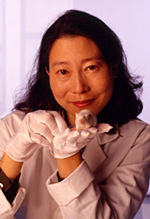|
7. Research into treatment for Alzheimer's disease is progressing, thanks to a genetically-modified mouse developed at the "U"

| U of M neurologist Karen Hsiao Ashe holds a transgenic mouse. She developed the mouse, which has an inherited form of Alzheimer's disease, in 1994. The offspring of the original mouse are used in a wide variety of experiments to develop treatments for Alzheimer's.
(Photo courtesy of Mark Luinenberg)
|
The transgenic mouse is a million-dollar rodent. In 1996, a University of Minnesota team led by neurologist Karen Hsiao Ashe developed a mouse with an inherited form of Alzheimer's disease. Its offspring are being used in research laboratories across the country to develop and test new treatments for Alzheimer's, the brain-wasting disease which affects hundreds of thousands of people. Since the university filed its first patent application for the transgenic mouse seven years ago, it has earned more than $3 million in royalties.
To develop the mouse, Dr. Hsiao Ashe inserted an Alzheimer's gene directly into the genetic material of the mouse. The animal then suffered the same decline from Alzheimer's disease experienced by humans - lost memory and wasted brain cells.
Early in its life, the transgenic mouse appears normal. But at about nine months, it develops symptoms similar to Alzheimer's. Such mice have difficulty performing various memory tasks when compared with a control group of mice.
"Because the mouse develops the disease in a year, rather than the 70 years it takes in people, experiments can now be done much more quickly," says Hsiao Ashe. "Mice can also be studied throughout the course of the illness so we have a better understanding of how it begins. Therapies with the best chances for success should be directed at the early stages of the disease before neurons die."
The development of the transgenic mouse is considered a breakthrough in Alzheimer's disease research, because the mouse displays the pathology of the disease as well as the symptoms. Therefore, it can be used to test drugs that affect the disease process itself, not just those that treat the symptoms.
"The first mouse is the forefather of tens of thousands of offspring that are now being used to study how the disease progresses and what compounds can be used to prevent or slow its progress," says Hsiao Ashe. "Over 150 research groups around the world, as well as a half dozen major pharmaceutical companies, are using the progeny of this mouse to conduct their own experiments."
Hsiao Ashe's mouse model was named by Harvard Medical School as one of the top 10 medical advances of 1996.
|